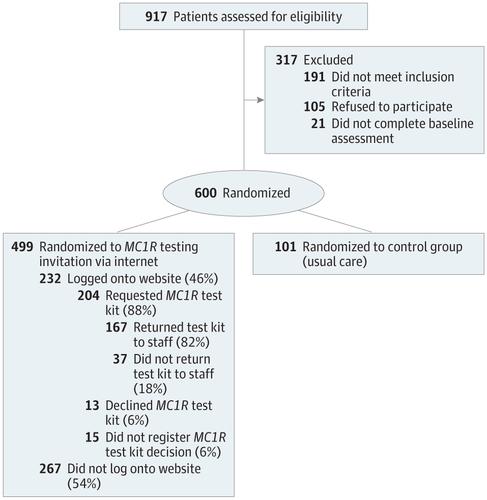JAMA Dermatology ( IF 11.5 ) Pub Date : 2018-06-01 , DOI: 10.1001/jamadermatol.2018.0592 Jennifer L. Hay 1 , Kate Zielaskowski 2 , Kirsten Meyer White 3 , Kimberly Kaphingst 4, 5 , Erika Robers 6 , Dolores Guest 7 , Andrew Sussman 8 , Yvonne Talamantes 7 , Matthew Schwartz 7 , Vivian M. Rodríguez 9 , Yuelin Li 1 , Elizabeth Schofield 1 , Jessica Bigney 10 , Keith Hunley 11 , David Buller 12 , Marianne Berwick 13, 14

|
Importance Germline variants in the MC1R gene are common and confer moderate melanoma risk in those with varied skin types. Approaches to precision skin cancer prevention that include genetic information may promote risk awareness and risk reduction in the general population, including Hispanics.
Objective To examine prevalence of interest in and uptake of MC1R testing in the general population and examine patterns across demographic and skin cancer risk factors.
Design, Setting, and Participants A randomized clinical trial examined interest in and uptake of MC1R testing among patients at University of New Mexico General Internal Medicine clinics. Study participants were randomized to either a usual-care condition (National Cancer Institute skin cancer pamphlet for diverse skin types) or an MC1R test offer. Participants were registered clinic patients (≥6 months) and English or Spanish fluent. Of the 600 participants recruited to the overall trial, the present study included those 499 participants randomized to the MC1R test offer.
Interventions Participants were presented with the option to log onto the study website to read 3 educational modules presenting the rationale, benefits, and drawbacks of MC1R testing.
Main Outcomes and Measures Main outcomes include website log on (yes vs no), saliva test kit request (yes vs no), and saliva test kit return for MC1R testing (yes vs no). Demographic and skin cancer risk factors were examined as potential predictors of test interest and uptake.
Results Of the 499 participants (220 [44%] non-Hispanic white, 242 [48%] Hispanic, 396 [79%] female; mean [SD] age, 54 [14.3] years), 232 (46%) elected to learn about MC1R testing by logging onto the website; 204 (88%) of those who logged on decided to request testing; and 167 (82%) of those who requested testing returned the kit. The strongest predictors of website log on were race/ethnicity and education (non-Hispanic whites were more likely to log on [odds ratio for Hispanics vs non-Hispanic whites, 0.5; 95% CI, 0.3-0.7], as were more highly educated individuals [odds ratio for more than high school vs high school or less, 2.7; 95% CI, 1.7-4.3]). The strongest predictor of ordering the test was sunburn history (odds ratio, 5.4; 95% CI, 2.3-12.9 vs no sunburn history).
Conclusions and Relevance There were moderately high levels of MC1R test interest and uptake in this diverse sample. Addressing potential barriers to testing may be warranted as genomic information becomes integrated into general population approaches to the precision prevention of skin cancer.
Trial Registration ClinicalTrials.gov identifier: NCT03130569
中文翻译:

在不同的基层医疗人群中对黑色素瘤风险进行MC1R检测的兴趣和接受性随机临床试验
重要性 MC1R基因中的生殖系变异很常见,并且在皮肤类型各异的人群中具有中等程度的黑色素瘤风险。包括遗传信息在内的精确预防皮肤癌的方法可能会提高包括西班牙裔在内的普通人群的风险意识并降低风险。
目的 研究普通人群对MC1R检测的兴趣和接受程度,并研究人口统计学和皮肤癌危险因素的模式。
设计,环境和参与者 一项随机临床试验研究了新墨西哥大学普通内科诊所的患者对MC1R检测的兴趣和接受程度。研究参与者被随机分为常规护理条件(针对各种皮肤类型的美国国家癌症研究所皮肤癌手册)或MC1R测试项目。参加者为注册的临床患者(≥6个月),英语或西班牙语流利。在招募至整个试验的600名参与者中,本研究包括随机分配给MC1R测试产品的499名参与者。
干预 参与者可以选择登录研究网站以阅读3个教育模块,这些模块介绍了MC1R测试的原理,优点和缺点。
主要结果和措施 主要结果包括网站登录(是vs否),唾液检测试剂盒要求(是vs否)以及用于MC1R测试的唾液检测试剂盒返回(是vs否)。人口统计学和皮肤癌危险因素被检查为测试兴趣和摄入量的潜在预测指标。
结果 在499名参与者(220 [44%]非西班牙裔白人,242 [48%]西班牙裔,396 [79%]女性;平均[SD]年龄,54 [14.3]年),232(46%)当选通过登录网站了解MC1R测试;在登录的用户中,有204位(88%)决定请求测试;167位(82%)要求测试的人退还了该套件。网站登录的最强预测指标是种族/民族和教育(非西班牙裔白人更有可能登录[西班牙裔美国人与非西班牙裔白人的几率分别为0.5; 95%CI为0.3-0.7),而更高受过良好教育的人[高中与高中或以下的比率为2.7; 95%CI为1.7-4.3]。排序测试的最强预测因子是晒斑史(比值比为5.4; 95%CI为2.3-12.9,而无晒斑史)。
结论和相关性 在这个多样化的样本中,MC1R测试的兴趣和摄取水平中等偏高。随着基因组信息被整合到用于预防皮肤癌的一般人群方法中,可能需要解决测试的潜在障碍。
试验注册 ClinicalTrials.gov标识符:NCT03130569































 京公网安备 11010802027423号
京公网安备 11010802027423号